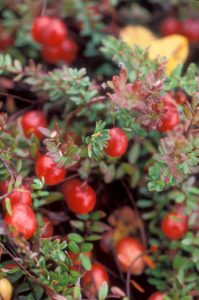The cranberry plant is native to large portions of the northeastern United States as well as the West Coast states and portions of Canada. Cranberry production requires a rather unique acid bog habitat, which restricts its commercial production to just a few states. Wisconsin, Massachusetts, New Jersey, Oregon, and Washington are the leading producers in the US.
The ideal soil pH is 4.0-5.5, quite acidic compared to other horticultural crops. A large supply of fresh water and sand is also required.
According to the USDA Agricultural Marketing Resource Center, Americans consume nearly 400 million pounds of cranberries per year, 20 percent of them during Thanksgiving week. The U.S. per capita consumption of cranberries is 2.3 pounds, mostly in the form of juice or juice blends.
Cranberries belong to the heath family Ericaceae and are related to rhododendron, blueberry and heather. Known botanically as Vaccinium macrocarpon, cranberries grow on a trailing, evergreen vine. The common name of cranberry comes from crane berry, so named because the flower is said to resemble the head and neck of a sandhill crane.
Because cranberries initiate flower buds in late summer, the plants need protection for the buds to survive. Thus, cranberry vines are flooded and layered with sand during the winter months to protect them from the cold. In spring, the bogs are drained. The plants flower in late spring and early summer on short, vertical shoots. The forthcoming fruit take the rest of the growing season to ripen.
Cranberries are harvested in September and October by one of two methods. Most are harvested via a “wet” method, where growers flood the plants and loosen the fruit by machine. The fruit then floats to the top. Most of these berries are used for processing. Some fruits are harvested for fresh market via a “dry” method, using mechanical comb-like pickers.
Fresh cranberries can be stored for 3-4 weeks in the refrigerator. In addition to being a source of vitamins C, A, and E, potassium and fiber, cranberries have other health benefits, including antimicrobial and antioxidant compounds.
